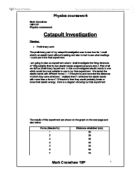I predict that when we use a force of 10 Newtons to propel the beaker, it will travel further than if we used a smaller force. I think this because of Newton’s Second Law which states: “If there is an Unbalanced Force, then the object will accelerate in that direction”.
This basically means that when a force is exerted on an object it will move in the direction that the force is going. But, there are always two forces acting on an object, in opposite directions. Newton states that the bigger force acting on an object will move that object forwards. Hence, Newton’s Second Law. I also know that when I increase the force, I will be increasing the distance travelled because of the fact that a bigger force will give more energy to the beaker, which will push the beaker further than a smaller force.
To make sure that this test is safe I will wear safety goggles. I will also use a plastic beaker, so if it does fall on the floor, it will not break.
I will repeat my results 4 times so that I can find any anomalous results.
I will be testing the forces: 2, 4, 6, 8 and 10N.
Secondary data
Newton’s First Law
So long as the forces on an object are balanced, then it’ll just stay still, or else if it’s already moving it’ll just carry on at the same velocity – so long as the forces are balanced
Newton’s Second Law
“If there is an Unbalanced Force, then the object will accelerate in that direction”
Newton’s Third Law
“If object A exerts a force on object B then object B exerts the exact opposite force on object A”
Obtaining evidence
As you can see I had quite a few anomalous results. Some are minor and happen only once or twice on the tests, but the entire 10N force test results were different.
Analysis
As you can see from my table and my graph (on another sheet) you can see that as I increased the force used to propel the beaker, so did the distance that it travelled.
As you can see between points 8 and 10 on the graph there is a dramatic increase in the distance travelled. Normally you would expect the distance travelled to go up at a steady rate as the force used increases, but in my experiment it didn’t. I think that this is probably due to the fact that the test wasn’t very accurate.
However, my prediction was correct: that when we use a larger force to propel the beaker across a surface, it will travel further than if we propel it with a smaller force. This is due to Newton’s Third Law: “If there is an Unbalanced Force, then the object will accelerate in that direction”.
This proves that the force that pushed the beaker across the table was greater than the force that was stopping the beaker. As a result the beaker slid across the table.
Evaluation
I think that my experiment gave inaccurate results as it was difficult to get the right amount of force used to propel the beaker. For example as I had to remove the Newton meter from the elastic band, so it didn’t get damaged, there was no way of telling whether the band was still at the same force when I released it to when I took the meter of it. Also the stool could have moved after the meter was removed, which means the elastic band could have lost or gained force. One way of stopping this could be to properly secure the stool to the table, so that it didn’t move, but then it would still leave the problem of the elastic bad moving.
I think that my results were fairly accurate as if we look at the graph the results are spread quite evenly and they do go up evenly rather than going up, and dropping down. The anomalous results were probably caused by the fact that the elastic band probably moved a bit after I removed the Newton meter. I think that the results for the 10N force are all a bit inaccurate as because I was using a big force the elastic was tighter, so therefore it was harder to keep in the right place.








